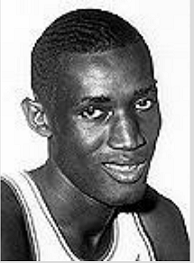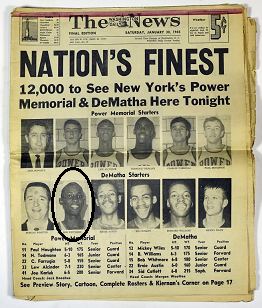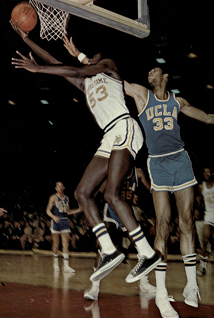It’s easy to understand why Bob Whitmore will be inducted into Notre Dame Basketball’s Ring of Honor Saturday afternoon.

- He averaged 18.8 points and 12.4 rebounds during his three-year career (1966-67 through 1968-69)
- He is #5 on ND’s career rebounding list.
- He is one of five Notre Dame basketball players with more than 1,000 career points and 1,000 career rebounds.
- He is #3 in career double-doubles at Notre Dame including six 20-20 games.
- Two of his seasons are tied for sixth on the season double-double list, 1966-67 and 1967-68
- He is #15 on the Fighting Irish career scoring with 1,580 points.
- He owns the #12 Notre Dame scoring season, 661 points in 30 games (1967-68).
- He was named to Notre Dame’s All-Century Team in 2004 along with teammate Bob Arnzen.
But statistics only tell part of Whitmore’s Notre Dame Basketball story.
The Greatest Game Ever Played
It began at DeMatha High School in Washington DC where Whitmore played for a promising young coach named Morgan Wootten. It gained legend status in 1965 when undefeated DeMatha ended Power Memorial’s 71-game winning streak in a game many still consider the greatest high school basketball game ever played. Power Memorial, from New York City, featured a pretty good center named Lew Alcindor.
The two teams played the previous season, a 65-62 Power Memorial victory. Whitmore, DeMatha’s 6’7” center, was responsible for guarding Alcindor.
From the CapitolBasketball.com account of the game:
“We will use a man-for-man defense and (6-foot-8) Bob Whitmore will guard Alcindor,” Wootten announced. “But we plan to give him some help.”
The enormity of DeMatha’s task became all too clear at a special dinner the evening before the game that brought both teams together. When it came time for the invocation, everyone in the room stood up – including Alcindor.
As the New York giant rose from his chair, DeMatha forward Sid Catlett elbowed his buddy Whitmore in the ribs to get his attention and nodded toward Alcindor.
“He just kept going up and up – like a rocket ship,” Whitmore recalled. “And my heart started going down, down, down. I’m realizing I have to contend with this guy at 6-7 or 6-8.”
Whitmore’s worst fears were realized. Alcindor was every bit as good as advertised. He dominated inside, scoring 35 points on 16-for-24 shooting. He also grabbed 17 rebounds and was clearly the difference in Power’s 65-62 victory.
Then came the rematch. Paul Mirengoff covered the game.

DeMatha had no superstar and its starting center, Bob Whitmore, was 6-7. Yet there was little doubt (at least at my Maryland high school) that their fab five — Whitmore, Bernie Williams, Sid Catlett, Ernie Austin, and Mickey Wiles — had the potential to beat Power Memorial. In fact, DeMatha had nearly done so the previous year at Cole, falling by a 65-62 margin after Whitmore fouled out (if I remember correctly). Alcindor scored 38 points in that one.
DeMatha coach Morgan Wootten spent the next 12 months gearing up for the rematch. For example, Catlett, who was 6-8, is said to have used a tennis racket during practice to allow the offense to practice against Alcindor-caliber shot blocking.
This time around, Wootten had Whitmore and Catlett double-team Alcindor. The strategy helped limit the great one to 16 points and DeMatha triumphed 46-43. Catlett (only a sophomore) had 13 points, including seven out of his team’s final nine. Williams contributed 12 points.
The game was covered by Sports Illustrated and the two major weekly news magazines. The coverage brought high school basketball a level of exposure it had never enjoyed before.
The two games also put DeMatha and its young coach on the map. The program would become perhaps the most storied in the country. When Wootten retired in 2002, his teams had amassed 1274 wins (and 192 losses), and he had already been inducted into the basketball Hall of Fame.
Each member of DeMatha’s fab-five would play major college basketball — Whitmore and Catlett at Notre Dame; Williams at La Salle, Austin at Syracuse, and Wiles at Maryland. Whitmore would have the dubious honor of guarding Alcindor in the annual UCLA-Notre Dame contest. UCLA won each game, but Catlett played for the Notre Dame team that defeated UCLA’s national championship team in 1971, after Alcindor graduated.
Only Bernie Williams had a substantial pro career (two years in the NBA and three in the ABA). But the fab-five is still remembered after all of these years for their landmark victory, a triumph of teamwork over individual prowess.
Notre Dame
Notre Dame Basketball was not performing to its historical standard in the early and mid 1960s – 10-14 for the 1963-64 season, 15-12 in 1964-65, and 5-21 in 1965-66. Three freshmen who were not eligible to play in those days were determined to change ND’s fortunes – Dwight Murphy, Arnzen, and Whitmore; but it was Whitmore opening the DC pipeline to Notre Dame that changed Irish fortunes.
Head Coach Johnny Dee’s long time friend Frannie Collins identified Whitmore as a potentially great player and great fit at Notre Dame; and once Whitmore was on campus, Collins made sure a young black man’s transition from Washington DC to Northern Indiana was as easy as possible.
Whitmore told author Michael Coffey for Echoes on the Hardwood, the definitive history book about Notre Dame Basketball, “I can’t say anything about Frannie without including his wife, Helen. Outside of my family, They were probably the biggest influences in my life. They’d send me articles from the paper at home when I was lonely that first year… And they never got anything out of it other than maybe coming to see us play a couple of times. I have so much love for them, it’s hard to find the words. They’re classics.”

The promise of a Notre Dame turnaround didn’t appear to be in the offing early in Whitmore’s first season of varsity basketball. The Irish started 2-9 including a blowout loss to UCLA and that Alcindor fellow from Power Memorial; but a stunning upset victory over Elvin Hayes (defended by Whitmore) and the University of Houston convinced the Irish that better days were ahead of them. They finished the 1966-67 with a 14-14 record.
The next season was Whitmore’s best statistically, 22.0 points and 13.8 rebounds per game; and the Irish improved to 21-9. Meanwhile three talented freshmen from DC, Whitmore’s high school teammate Sid Catlett, Collis Jones, and Austin Carr were preparing to join Arnzen and Whitmore on the varsity for the 1968-69 season.
Whitmore and Arnzen both averaged 17.7 points that season while that Carr guy started to make a name for himself with his 22.1 ppg average. Whitmore averaged 9.4 rebounds, and Arnzen grabbed 11.6 boards per game as the Irish again won 21 games.
Ring of Honor
“One of the class acts that we’ve had here,” Mike Brey said after last Saturday’s game. “You can argue who should go up next in the Ring of Honor. I always tell our former guys, ‘Work with me. We’re starting late. I know there’s a lot of guys who should be up there.’
“When we’ve selected a guy, I’ve always gotten an email or a phone call asking ‘What about so-and-so?’ It was unanimous with Bob Whitmore. What a great choice! He needs to be up there.”
Why unanimous? Because Whitmore was and is much more than his eye-popping statistics say he is. As DC stars followed Whitmore to Notre Dame, even through the days of Adrian Dantley and Duck Williams; Whitmore paid Frannie and Helen Collins’ kindness forward.
“He did a heck of a job with young players, especially African American players at a time when they were trying to get a feel for Notre Dame,” Brey said. “I know he was an unbelievable mentor to a Dantley and a Shumate. They all talk glowingly about him.”
Trailblazer, mentor, star… and member of the Ring of Honor. Congratulations, Bob Whitmore.
John F. Manion says:
Please add me to your list so I may share in all the good Notre Dame FIghting Irish reports; I’m Class Secretary for the Notre Dame Class of 1956